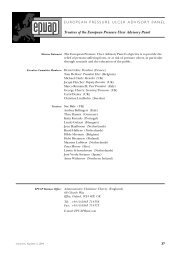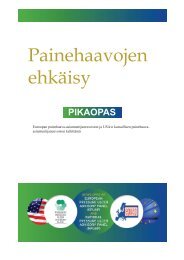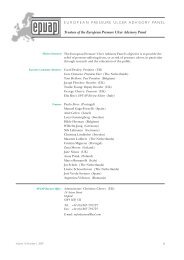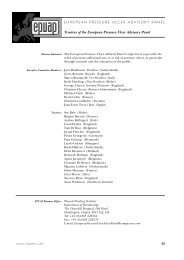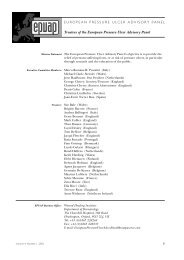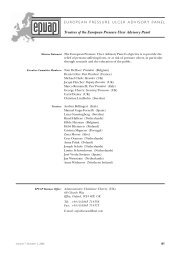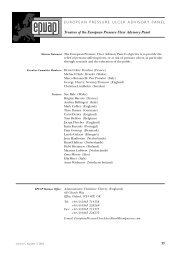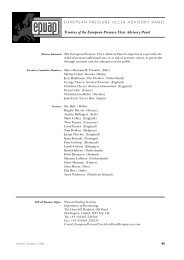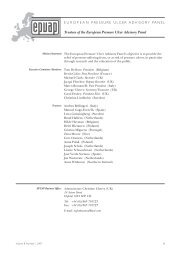SCALE Final Consensus Statement - European Pressure Ulcer ...
SCALE Final Consensus Statement - European Pressure Ulcer ...
SCALE Final Consensus Statement - European Pressure Ulcer ...
You also want an ePaper? Increase the reach of your titles
YUMPU automatically turns print PDFs into web optimized ePapers that Google loves.
or injury. 29 It encompasses everything from<br />
macular lesions (color changes without elevation<br />
or depression of the skin) through total skin<br />
breakdown.<br />
Maintenance (wound): An attempt to keep an ulcer<br />
from deteriorating by providing good wound care.<br />
The wound may not heal due to patient choice or<br />
a lack of the health care system to provide optimal<br />
resources to promote healing.<br />
Non-healable (wound): A wound that often<br />
deteriorates and occurs on an individual whose body<br />
cannot support the phases of wound healing within<br />
the individuals expected lifetime. There may be<br />
inadequate vascular supply to support healing or the<br />
cause of the wound cannot be corrected.<br />
Palliative skin care: Providing comfort and<br />
support for the bodies cutaneous surface (part of<br />
the practice of palliative medicine) is not a timeconfined<br />
but rather a goal-oriented and patientcentered<br />
care delivery model. 50 Palliative wound care<br />
is the evolving body of knowledge and skills that<br />
take a holistic approach to relieving suffering and<br />
improving quality of life for patients (individuals)<br />
and families living with chronic wounds, whether<br />
the wound is healable, can be maintained or may<br />
deteriorate. 32<br />
Patient circle of care: This is not a legal term,<br />
but rather a social term that includes all of the<br />
stakeholders in the patient’s health and well being.<br />
The term includes, but is not limited to, the patient,<br />
a legal guardian or responsible party, a spouse<br />
or significant other, interested friends or family<br />
members, caregivers, and any other individual(s)<br />
who may have an interest in the patient’s care and<br />
well being.<br />
<strong>Pressure</strong> <strong>Ulcer</strong>: A pressure ulcer is localized injury<br />
to the skin and/or underlying tissue usually over a<br />
bony prominence, as a result of pressure, or pressure<br />
in combination with shear and/or friction. A<br />
number of contributing or confounding factors are<br />
also associated with pressure ulcers; the significance<br />
of these factors is yet to be elucidated. 51<br />
Scale (skin): Surface keratin that may be thick or<br />
thin, resembling a fish scale, cast off (desquamating)<br />
from the skin. 29<br />
<strong>SCALE</strong>: The acronym for Skin Changes at Life’s<br />
End.<br />
Skin breakdown: An interruption in the integrity<br />
of the skin surface leading to defect in the epidermal<br />
covering with an epidermal, dermal or deeper base.<br />
Skin compromise: A state in which skin’s protective<br />
function is at risk of breaking down.<br />
Skin failure: An acute episode where the skin and<br />
subcutaneous tissues die (become necrotic) due to<br />
hypoperfusion that occurs concurrent with severe<br />
dysfunction or failure of other organ systems. 8<br />
Skin tear: A traumatic wound occurring principally<br />
on the extremities of older adults as a result of<br />
friction alone or with shearing and frictional forces<br />
that separate the epidermis from the dermis (partialthickness<br />
wound) or a deeper split that separates<br />
both the epidermis and the dermis from the<br />
underlying structures (full-thickness wound). 30<br />
Stakeholders: An individual, facility, or organization<br />
with an interest in Skin Changes at Life’s End<br />
(<strong>SCALE</strong>).<br />
Stage I <strong>Pressure</strong> <strong>Ulcer</strong>: Intact skin with nonblanchable<br />
redness of a localized area usually over a<br />
bony prominence. Darkly pigmented skin may not<br />
have visible blanching; its color may differ from the<br />
surrounding area. 51<br />
Stage II <strong>Pressure</strong> <strong>Ulcer</strong>: Partial thickness loss of<br />
dermis presenting as a shallow open ulcer with a red<br />
pink wound bed, without slough. May also present<br />
as an intact or open/ruptured serum-filled blister. 51<br />
Stage III <strong>Pressure</strong> <strong>Ulcer</strong>: Full thickness tissue loss.<br />
Subcutaneous fat may be visible but bone, tendon<br />
or muscle are not exposed. Slough may be present<br />
but does not obscure the depth of tissue loss. May<br />
include undermining and tunneling. 51<br />
Stage IV <strong>Pressure</strong> <strong>Ulcer</strong>: Full thickness tissue loss<br />
<strong>SCALE</strong> <strong>Final</strong> <strong>Consensus</strong> <strong>Statement</strong>, October 1, 2009 Page 15



